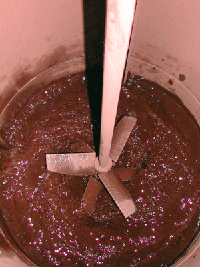Red Mud is produced during the Bayer process for alumina production. It is the insoluble product after bauxite digestion with sodium hydroxide at elevated temperature and pressure. It is a mixture of compounds originally present in the parent mineral, bauxite, and of compounds formed or introduced during the Bayer cycle. It is disposed as a slurry having a solid concentration in the range of 10-30%, pH in the range of 13 and high ionic strength.
A chemical analysis would reveal that RM contains silica, aluminum, iron, calcium, titanium, as well as an array of minor constituents, namely: Na, K, Cr, V, Ni, Ba, Cu, Mn, Pb, Zn etc. The variation in chemical composition between different RMs worldwide is high. Typical values would account:
|
Fe2O3
|
30-60wt%
|
|
Al2O3
|
10-20wt%
|
|
SiO2
|
3-50wt%
|
|
Na2O
|
2-10wt%
|
|
CaO
|
2-8wt%
|
|
TiO2
|
trace-25wt%
|
(Source: The International Aluminium Institute, modified for the TiO2 content)
Mineralogically, RM has a very high number of compounds present. The more frequent addressed are:
hematite (Fe2O3), goethite Fe(1-x)AlxOOH (X=0-0.33), gibbsite Al(OH)3, boehmite AlO(OH), diaspore AlO(OH), calcite (CaCO3), calcium aluminum hydrate (x.CaO.yAl2O3.zH2O), quartz (SiO2), rutile (TiO2), anatase (TiO2), CaTiO3, Na2TiO3, kaolinite Al2O3.2SiO2.2H2O, sodalites, aluminum silicates, cancrinite (NaAlSiO4)6.CaCO3, hydroxycancrinite (NaAlSiO4)6.NaOH.H2O, chantalite CaO.Al2O3.SiO2.2H2O, hydrogarnet Ca3Al2(SiO4)n(OH)12-4n
The inorganic RM phases which are not contained in bauxite can be divided into three groups [W. Kurdowski, F. Sorrentino, 1997]:
“NAS” phases: 3(Na2O Al2O3 2SiO2)Na2X (X=CO2 2-, 2OH-, SO4 2-, 2Cl-)
“CAS-CFS” phases: 3CaO(Fe2O3)x (Al2O3)1-x kSiO2 (6-2k)H2O
“NT-CT” phases: Na2Ti3O7.3H2O, kassite, perovskite, portlandite
A wide variety of organic compounds are also present. The following compounds have been reported [A.R. Hind et al, 1999]:
Polybasic and polyhydroxy acids, alcohols and phenols, humic and fulvic acids, carbohydrates, sodium salts of succinic, acetic and oxalic acids
These organic compounds, giving RM a distinctive odour, are derived largely from decomposed vegetation and roots. Under the alkaline oxidative conditions existing in the Bayer process, they break down to more simple compounds such as the sodium salts of succinic, acetic and oxalic acids. Predominant among these salts is sodium oxalate.
RM is a very fine material in terms of particle size distribution. Typical values would account for 90 volume % below 75µm. The specific surface (BET) of RM is around 10m2/g.
As it is apparent RM is a highly complex material that differs due to the different bauxites used and the different process parameters. Therefore RM should be regarded as a group of materials, having particular characteristics, such:
Produced during the Bayer process
Water suspensions and highly alkaline
Mainly composed of iron oxides and have a variety of elements and mineralogical phases
Relatively high specific surface/fine particle size distribution
Red mud in “as it is” state, solid concentration ~400g/l
Red mud after water evaporation
Bibliography
W. Kurdowski, F. Sorrentino, in “Waste Materials Used in Concrete Manufacturing”, pp. 290-308, Edited by Satish Chandra, William Andrew Publishing/Noyes, 1997
A. R. Hind, S. K. Bhargava, Stephen C. Grocott, “The surface chemistry of Bayer process solids: a review”, Colloids and Surfaces A : Physicochem. Eng. Aspects, 146 (1999) 359–374
Text written by Y. Pontikes. Reflects only personal opinions. Last updated May 2, 2005

